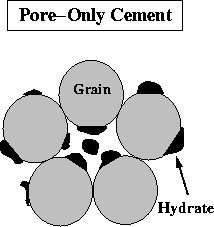




Next: Saturated elastic moduli for
Up: HYDRATE FORMATION MODELS
Previous: Hydrate formation by cementation
Another possible means of hydrate formation might be the solidification of the
methane in the pore space only, away from the grain contacts
(Figure 2).
In this case the hydrate
is solidified, but does not become part of the dry rock matrix by cementation.
The rock grains are held together only by the effect of the confining pressure.
An increase in stiffness would result only at considerable hydrate saturation of
the pore space, in contrast to the previously-described cementation case.
The effective dry moduli of the hydrate-bearing sandstone at
critical porosity  can be described by the
Hertz-Mindlin contact theory Mindlin (1949):
can be described by the
Hertz-Mindlin contact theory Mindlin (1949):
|  |
(5) |
|  |
(6) |
where  is the grain Poisson's ratio, G is the grain shear moduli and
P is the confining pressure.
is the grain Poisson's ratio, G is the grain shear moduli and
P is the confining pressure.
nocement.pore
Figure 2 Configuration of the rock matrix
after deposition of the hydrate as pore-only cement.
|
|  |

In order to calculate the effective dry moduli at a different porosity,
we used the heuristically modified Hashin-Strikman lower bound proposed by
Dvorkin and Nur 1995:
|  |
(7) |
|  |
|
| (8) |
where K is the grain bulk modulus, and  is the original porosity of the
grains.
is the original porosity of the
grains.





Next: Saturated elastic moduli for
Up: HYDRATE FORMATION MODELS
Previous: Hydrate formation by cementation
Stanford Exploration Project
11/12/1997



![]() is the grain Poisson's ratio, G is the grain shear moduli and
P is the confining pressure.
is the grain Poisson's ratio, G is the grain shear moduli and
P is the confining pressure.



![]() is the original porosity of the
grains.
is the original porosity of the
grains.